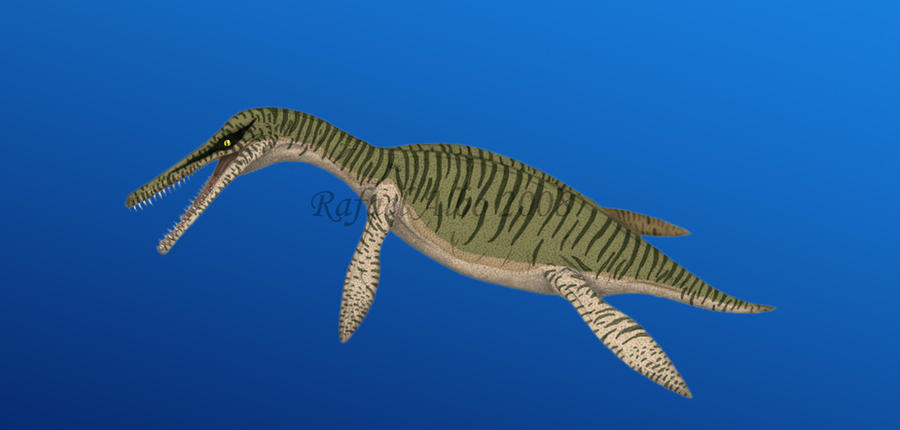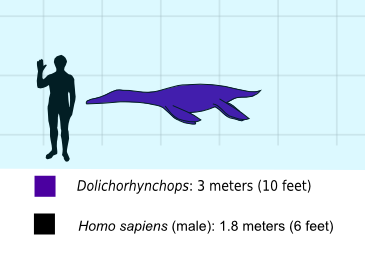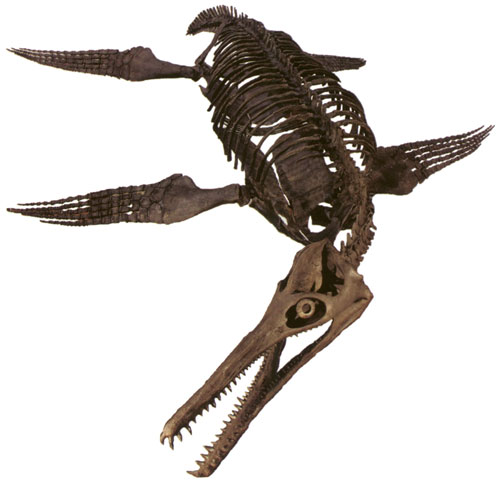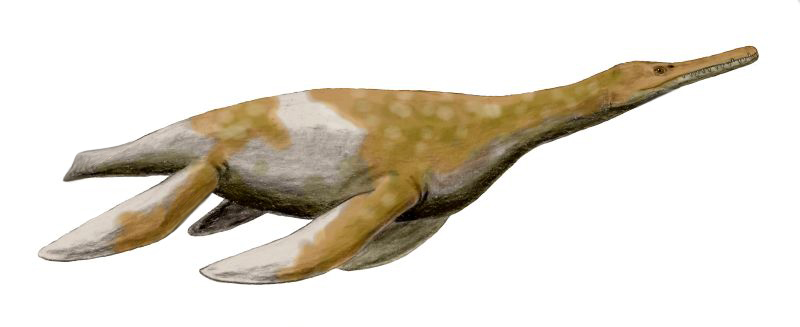[Recent Entries][Archive][Friends][User Info]
December 29th, 2013
| December 29th, 2013 | |
|---|---|
| 01:53 pm [industrialterro] [Link] |
Dolichorhynchops Dolichorhynchops is an extinct genus of polycotylid plesiosaur from the Late Cretaceous (early Turonian to late Campanian stage) of North America, containing three species, D. osborni, D. herschelensis and D. tropicensis. Dolichorhynchops was an oceangoing prehistoric reptile. Its Greek generic name means "long-nosed eye," perhaps because its eyes seem placed rather far forward on its lengthy snout. The holotype specimen of Dolichorhynchops osborni was discovered in the upper Smoky Hill Chalk Logan County, Kansas, by George F. Sternberg, as a teenager, in around 1900. The remains were collected by him and his father, Charles H. Sternberg, and then sold to the University of Kansas (Lawrence, Kansas). KUVP 1300 was prepared and mounted by H.T. Martin under the supervision of Dr. Samuel Wendell Williston, who described and named it in 1902. A more detailed description and photographs were provided by Williston 1903). The specimen has been on display in the KU Museum of Natural History since that time. In 1918, Charles H. Sternberg found a large mosasaur, Tylosaurus, with the remains of a plesiosaur in its stomach. The mosasaur specimen is currently mounted in the United States National Museum (Smithsonian) and the plesiosaur remains are stored in the collections. Although these important specimens were briefly reported by Sternberg 1922, the information was lost to science until 2001. This specimen was rediscovered and described by Everhart 2004a. It is the basis for the story line in the 2007 National Geographic IMAX documentary Sea Monsters: A Prehistoric Adventure, and a book by the same name Everhart 2007. George Sternberg found a second, less complete specimen of D.osborni in 1926. In his effort to sell the specimen to a museum, Sternberg took detailed photographs of the skull. The specimen was eventually mounted in plaster and was acquired by the Harvard Museum of Comparative Zoology. MCZ 1064 was on display there until some time in the 1950s. This specimen was never completely described although the skull was figured by O'Keefe 2004. (See also Everhart 2004b) The specimen of D. osborni on exhibit at the Sternberg, FHSM VP-404 was found by Marion Bonner near Russell Springs in Logan County in the early 1950s. It is, perhaps, the most complete specimen of this species known. It is just under 10 feet in length. The skull was crushed flat but is in very good condition. This specimen was initially reported by Sternberg & Walker 1957, and then was the subject of a Masters thesis by Orville Bonner 1964. Note that it was described by Bonner as "Trinacromerum osborni" which was the accepted genus name at the time. Two very large specimens of a polycotylid plesiosaur (KUVP 40001 and 40002) were collected from the Pierre Shale of Wyoming and later reported on by Adams in her 1977 Masters thesis. Later (1997), she officially described (1997) as a new species of Trinacromerum (T. bonneri). Unknown to her at the time, Carpenter (1996) had revised the Polycotylidae and separated Dolichorhynchops from Trinacromerum. Thus the species would revert to Dolichorhynchops bonneri, but there is some question as to whether or not the specimens represent a separate species or just larger individuals of D. osborni. The question has yet to be resolved. Until recently, all known specimens of D. osborni in Kansas had been collected from the upper layers of the Smoky Hill Chalk (Campanian age). Everhart 2003 reported the first remains from the lower chalk (Late Coniacian-Santonian in age). In 2005, the remains of the earliest known D. osborni were discovered in the Fort Hays Limestone, Niobrara Formation in Jewell County, Kansas. This is the first record of a polycotylid plesiosaur in this formation. D. herschelensis was described as a new species by Tamaki Sato in 2005. It was discovered in the Bearpaw Formation of Saskatchewan, Canada, a Late Cretaceous (late Campanian to Maastrichtian) rock formation. The fossil was found close to the town of Herschel in south-western Saskatchewan, from which the species name is derived. The rock formation it was found in consists of sandstones, mudstones and shales laid down in the Western Interior Seaway, just before it began to revert to dry land. The type specimen of D. herschelensis was discovered in a disarticulated state (i.e. the bones were scattered about the discovery site). The skull, lower jaw, ribs, pelvis and shoulder blades were all recovered, but the spine was incomplete, so the exact number of vertebrae the living animal would have had is unknown. All four limbs are missing, with the exception of 9 small Phalanges (finger bones) and a small number of limb bones found close by which may belong to the animal in question. The specimen is believed to be an adult, due to the fusion of certain bones (it is generally assumed—not necessarily strictly correctly so—that other animals' skulls, much as humans', consist of dissociated bones interconnected by cartilage fontanelles that do not entirely close until full maturity). It is also believed to have been substantially smaller than its close relative, D. osborni, as some juvenile specimens of D. osborni are larger than the adult specimen of D. herschelensis. Assuming that only a few vertebrae are missing from the skeleton, the animal is estimated to be about 2.5 to 3 metres in length. The snout is long and thin, with numerous tooth sockets. However, very few of the thin, sharp teeth remain. D. tropicensis was first named by Rebecca Schmeisser McKean in 2011. The specific name is derived from the name of the Tropic Shale, in which the two specimens of D. tropicensis were found. It is known from the holotype MNA V10046, an almost complete, well-preserved skeleton including the most of the skull and from the referred specimen MNA V9431, fragmentary postcranial elements. It was collected by the Museum of Northern Arizona from a single locality within the Tropic Shale of Utah, dating to the early Turonian stage of the early Late Cretaceous, about 93.5-91 million years ago. D. tropicensis extends the known stratigraphic range for Dolichorhynchops back by approximately 7 million years. Previously three additional polycotylid taxa, Eopolycotylus, Palmulasaurus and Trinacromerum, have been named from the same formation, two of which are currently endemic to the Tropic Shale. Репродукции (1, 2, 3, 4, 5, 6, 7, 8, 9): ( Read More ) Размеры тела в сравнении с человеком: Ископаемые останки (1, 2, 3, 4, 5): Tags: Вымершие рептилии, Мел, диапсиды, завроптеригии, лепидозавроморфы, плезиозавроиды, плезиозавры, поликотилиды |
| Time | Event |
| 02:58 pm [industrialterro] [Link] |
Trinacromerum Тринакромерум (Trinacromerum, от др.-греч. τριν- +ακρο- +μῆρον, «трёхвершинное бедро») — род вымерших рептилий из надотряда завроптергий, подотряда плезиозавров. Этот род включает два вида. Первый — Trinacromerum osborni, описанный палеонтологом Крагином в 1888 году. Второй — Trinacromerum bentonianum (типовой), открытый в 1908 году Уиллистоном. Синонимы — Ceraunosaurus brownorum, Dolichorhynchops kirki, Dolichorhynchops willistoni,Trinacromerum anonymum, Trinacromerum brownorum, Trinacromerum willistoni. Тринакромерум относится к семейству поликотилид и является близким родственником более известного долихоринхопса. В частности, он походил на него по своему внешнему виду и поведению. Тринакромерум — один из самых хорошо сохранившихся поликотилид. Этот ящер являлся плезиозавром, несмотря на то, что шея у него, была укороченной. Его челюсти были удлинены и усеяны похожими на иглы зубами. Тело было устремлено вперед. Тринакромерум был рыбо- и плотоядным ящером. Его быстрота и маневренность помогали ему с успехом охотиться. Тем не менее, он, скорее всего, часто становился жертвой значительно более крупных плиозавров, таких, как брахаухениус, обитавших в тех же водах. Развивать высокую скорость тринакромеруму позволяли длинные плавники. Любопытно, что биолог Ричард Элли, описал внешний вид этого ящера, как похожий на «Пингвина с четырьмя плавниками». Это пресмыкающееся обитало на нашей планете в эпоху позднего мелового периода, примерно 90 миллионов лет назад (сеноманский — туронский ярусы), в мелководных морях, на территории которых сейчас расположен североамериканский материк (Канада — провинция Манитоба, США — Колорадо, Канзас, Техас и Юта). Это было время, когда последние плиозавры боролись за жизнь с более приспособленными к окружающей среде мозазаврами. Тринакромерум достигал 3-ёх метровой длины и веса в 1000 фунтов. Размеры тела в сравнении с человеком: Ископаемые останки (1, 2, 3, 4, 5): Tags: Вымершие рептилии, Мел, диапсиды, завроптеригии, лепидозавроморфы, плезиозавроиды, плезиозавры, поликотилиды |
| Time | Event |
| 04:23 pm [industrialterro] [Link] |
Polycotylus Polycotylus is a genus of plesiosaur within the family Polycotylidae. The type species is P. latippinis and was named by American paleontologist Edward Drinker Cope in 1869. Eleven other species have been identified. The name means 'much-cupped vertebrae', referring to the shape of the vertebrae. It lived in the seas of North America, Russia and Australia toward the end of the Cretaceous. One fossil preserves an adult with a single large fetus inside of it, indicating that Polycotylus gave live birth, an unusual adaptation among reptiles. Like all plesiosaurs, Polycotylus was a large marine reptile with a short tail, large flippers, and a broad body. It has a short neck and a long head, and was about 5 metres (16 ft) long. It has more neck vertebrae than other polycotylids, however. Polycotylus is thought to be a basal polycotylid because it has more vertebrae in its neck (a feature that links it with long-necked ancestors) and its humerus has a more primitive shape. The long ischia of the pelvis are a distinguishing feature of Polycotylus, as are thick teeth with striations on their surfaces, a narrow pterygoid bone on the palate and a low sagittal crest on top of the skull. Edward Drinker Cope named Polycotylus from the Niobrara Formation in Kansas in 1869. The holotype bones from which he based his description were fragmentary, representing only a small portion of the skeleton. A more complete skeleton was later found in Kansas and was described in 1906. A nearly complete skeleton was found in 1949 from the Mooreville Chalk Formation in Alabama, but was not described until 2002. Unlike some better-known long-necked plesiosaurs like Plesiosaurus and Elasmosaurus, Polycotylus had a short neck. This led to it being classified as a pliosaur, a marine reptile within the superfamily Pliosauroidea, closely related to true plesiosaurs (which belong to the superfamily Plesiosauroidea). Polycotylus and other polycotylids superficially resemble pliosaurs like Liopleurodon and Peloneustes because they have short necks, large heads, and other proportions that differ from true plesiosaurs. As phylogenetic analyses became common in the last few decades, the classification of Polycotylus and other plesiosaurs have been revised. In 1997, it and other polycotylids were reassigned as close relatives of long-necked elasmosaurids. In a 2001 study, Polycotylus was classified as a derived cryptocleidoid plesiosaur closely related to Jurassic plesiosaurs like Cryptocleidus. In 2007, Polycotylus was placed in a new subfamily of polycotylids called Polycotylinae. Another newly-described polycotylid called Eopolycotylus from Glen Canyon, Utah, was found to be the closest relative of Polycotylus. A fossil of P. latippinis catalogued LACM 129639 includes an adult individual with a single fetus inside it. LACM 129639 was found in Kansas during the 1980s and was in storage at the Natural History Museum of Los Angeles County until it was described in 2011. The length of the fetus is around 40 percent of the length of the mother. Gestation was probably two thirds complete based on what is known of the fetal development of related nothosaurs. This fossil suggests that Polycotylus was viviparous, giving live birth (as opposed to laying eggs). Vivipary, or live birth, may have been the most common form of reproduction in plesiosaurs, as they would have had difficulty laying eggs on land. Their bodies are not adapted to movement on land, and paleontologists have long hypothesized that they must have given birth in water. Other marine reptiles such as ichthyosaurs also gave live birth, but LACM 129639 was the first direct evidence of vivipary in plesiosaurs. The lives of Polycotylus and other plesiosaurs were K-selected, meaning that few offspring were born to each individual but those that were born were cared for as they mature. Because it gave birth to a single large offspring, the mother Polycotylus probably gave it some form of parental care for it to survive. F. Robin O'Keefe, one of the describers of LACM 129639, suggested that the social lives of plesiosaurs were "more similar to those of modern dolphins than other reptiles." K-selected life-history strategies are also seen in mammals and some lizards, but are unusual among reptiles. ( Read More ) Tags: Вымершие рептилии, Мел, диапсиды, завроптеригии, лепидозавроморфы, плезиозавроиды, плезиозавры, поликотилиды |
| Time | Event |
| 05:53 pm [industrialterro] [Link] |
Thalassomedon Талассомедон (Thalassomedon, от др.-греч. θᾰλασσομέδων «властелин моря») — род вымерших рептилий из надотряда зауроптеригий, отряда плезиозавров. Вероятнее всего, при своих размерах талассомедон был главным хищником своего времени. А вымер, возможно, в связи с появлением новых грозных плотоядных морских рептилий, таких, как тилозавр. Первое из известных открытий талассомедона датируется 1939 годом, когда палеонтолог Р. Л. Ланденберг обнаружил его голотип в США, в штате Колорадо. А свое название талассомедон получил в 1943 году, благодаря палеонтологу Сэмюэлу Полу Уэллесу. Талассомедон обитал на нашей планете в эпоху сеноманского яруса позднего мелового периода, в море, которое в ту эпоху разделяло на две части Северную Америку, примерно 95 миллионов лет назад. Помимо Колорадо, останки находят также в Монтане. Ближайшим родственником талассомедона был более известный эласмозавр, появившийся несколько позднее. Скелеты талассомедонов выставлены в шести американских палеонтологических музеях, в частности, в Американском музее Естественной истории в Нью-Йорке (голотип AMNH) и в Денверском музее Естественной истории (голотип DMNH). Известно, что черепа у скелетов, выставленных в трех из всех этих музеях — реконструкции, выполненные на основе разрушившихся окаменелостей. Талассомедон относится к эласмозавридам. Типовой вид — Thalassomedon haningtoni (часто встречаются ошибочные написания haringtoni, hanningtoni). В 1943-м Уэллес также описал род Alzadasaurus riggsi. В 1999 году палеонтолог Карпентер признал его синонимичным к Thalassomedon haningtoni. Другой род альзадазавра, A. colombiensis, был переименован в Callowayasaurus, остальные виды были признаны синонимичными по отношению к стиксозавру. При своей общей длине в 12 метров, талласомедон по меркам своего семейства был плезиозавром средних размеров, особенно в сравнении с гигантскими родственниками мауизаврами. При таких габаритах только его ласты были длиной от полутора до двух метров. В шее насчитывалось 62 позвонка. Длина черепа составляла 47 сантиметров, в то время как зубы составляли в длину 5 сантиметров. Весьма интересно, что при раскопках в желудках талассомедонов находят окаменевшие камни. Но если стиксозаврв использовали их для улучшения переваривания пищи (рыбы, которой они питались), то талассомедоны, вероятнее всего, использовали их только как балласт. Elasmosauridae was a family of plesiosaurs. They had the longest necks of the plesiosaurs and survived from the Late Triassic to the end of the Cretaceous. They had a diet of fish and shelless cephalopods. The earliest elasmosaurids were small, about 3 m (9.8 ft). At the end of the Cretaceous, elasmosaurids grew as large as 14 m (46 ft), such as Elasmosaurus. Their necks were the longest of all the plesiosaurs, with anywhere between 32 to 76 (Albertonectes) cervical vertebrae They weighed up to several tons. The family Elasmosauridae was erected by Cope in 1869, and anchored on the genus Elasmosaurus. Размеры тела в сравнении с человеком: Tags: Вымершие рептилии, Мел, диапсиды, завроптеригии, лепидозавроморфы, плезиозавроиды, плезиозавры, эласмозавриды |
| Time | Event |
| 06:46 pm [industrialterro] [Link] |
Aristonectes Aristonectes (meaning 'best swimmer') is an extinct genus of plesiosaur from the Late Cretaceous of what is now South America and Antarctica. The type species is Aristonectes parvidens, first named by Cabrera in 1941. Aristonectes has been classified variously since the 1941 description, but a 2003 review of plesiosaurs conducted by Gasparini et al. found that Aristonectes was most closely related to elasmosaurid plesiosaurs like Elasmosaurus. A similar plesiosaur, Morturneria, may be a junior synonym of Aristonectes, the study found. Aristonectes has been recently placed within its own family, along with Tatenectes, Kaiwhekea, and Kimmerosaurus, by O'Keefe and Street (2009). Aristonectids are the sister family of the polycotylid cryptoclidoids. Аристонект (Aristonectes parvidens) — описан Х. Кабрерой в 1941 году из маастрихта Аргентины (Чубут в Патагонии). Это первый из описанных аргентинских плезиозавров. Известен разрушенный череп, позвонки и кости левого переднего ласта. Череп низкий, широкий, с огромным количеством (45 пар на верхней челюсти и 58 на нижней) ячеек мелких зубов. Длина черепа около 73 см. Длина шеи около 2 метров, около 30 шейных позвонков, общая длина доходила до 7—8 метров. The Aristonectidae is a taxonomic family of poorly known plesiosaurs from the Jurassic and Cretaceous periods. They are closely related to polycotylid plesiosaurs. The family is made up of Tatenectes, Kimmerosaurus, Aristonectes, and Kaiwhekea. This group was formerly known as the Cimoliasauridae, but since Cimoliasaurus is indeterminate and quite possibly elasmosaurid, this replacement name was erected. Tatenectes and Kimmerosaurus represent an earlier Oxfordian Jurassic radiation from Laurasia, while Aristonectes and Kaiwhekea represent a later Cretaceous radiation from Gondwana. Aristonectidae were characterized by a relatively larger head and shorter neck than the Plesiosauridae and Elasmosauridae. Teeth resemble those of the Plesiosauridae. The group is known only from scanty and fragmentary remains. The formal diagnosis of the clade is that they possess: A snout that is relatively long but unconstricted and wide anteriorly; A paroccipital process of the opisthotic that articulates only with the squamosal; Teeth that are small and relatively narrow (crown length < 1 cm); Number of premaxillary teeth is 7 or more; Number of maxillary teeth is greater than 30; Palate with a ventrally expanded boss projecting out of the plane of the palate between the posterior and anterior interpterygoid vacuity; Number of cervical vertebrae greater than 32; Cervical vertebrae much wider than long; Cervical vertebrae with poorly defined rims of articular surfaces; Marked dorso-ventral constriction of cervical centra on ventral midline (binocular-shaped); Neural arch and canal very small relative to centrum diameter.
Tags: Вымершие рептилии, Мел, аристонектиды, диапсиды, завроптеригии, лепидозавроморфы, плезиозавроиды, плезиозавры |
| Previous Day | 2013/12/29 [Archive] |
Next Day |





























